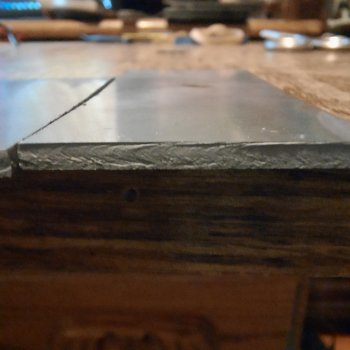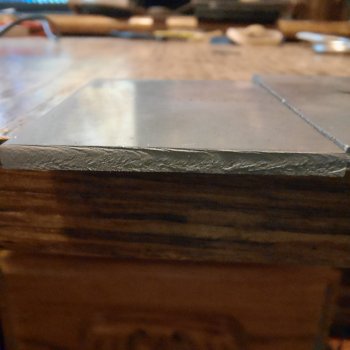You are using an out of date browser. It may not display this or other websites correctly.
You should upgrade or use an alternative browser.
You should upgrade or use an alternative browser.
Opinions On This Heat Treat
- Thread starter CDHumiston
- Start date
It's really hard for me to tell much from a photo, but that does "look" ok. By far the best way is to break an old file or drill bit and compare the grain structure of your coupon to the broken piece. To the eye the grain should look almost like a smooth grey look with no real visible grains.
Ken H>
Ken H>
Alden Cole
Well-Known Member
Ken nailed it. Did you break these pre or post tempering?
CDHumiston
Well-Known Member
Ken nailed it. Did you break these pre or post tempering?
Pre tempering.
billyO
Well-Known Member
Have you seen this picture yet, Chris?
Grain Refinement
After learning that grain refinement and normalizing are not the same thing, I was left with the question of how do I refine grain? Unlike some of you who know what you are doing, I am confident that I regularly overheat steel when forging. I don't do it on purpose, I'm just not that good at...
knifedogs.com
CDHumiston
Well-Known Member
Have you seen this picture yet, Chris?
Grain Refinement
After learning that grain refinement and normalizing are not the same thing, I was left with the question of how do I refine grain? Unlike some of you who know what you are doing, I am confident that I regularly overheat steel when forging. I don't do it on purpose, I'm just not that good at...knifedogs.com
I have, but still looking for opinions on here. This looks really good in person. Hard to capture a photo. Not quite as good as the factory heat treat, but I'm getting there...
Andre Grobler
Well-Known Member
i am gong to be speculating here... as from the photos not much in terms of grain SIZE can be seen, grain structuring i would prefer not to see, as that is usually referring to carbide banding.
First first thing... it sounds like are eheat treating in a forge? might be useful to describe what you did for heat treatment...
second thing, you could overheat aebl quite a bit before you get graingrowth, it has very fine carbides to pin the grains, i wouldn't bother with grain refinement, unless you forge it, and even then, i will guess that forging temps for aebl is well below the grain growth point, and forging wouldn't upset much in this steel, unless it gets sparkly. which is a different story altogether.
i would think you are much more likely to get retained austenite if you overheated it for your quench speed and level of cold treatments... i believe if you had quite a bit of that, you would see lots of tearing and bending in the steel when it snaps. having said that, i haven't actually done it, to aebl, so the untempered martensite might still be the larger part which would cause a brittle fracture.
if you want a decent photo with a phone, try sunlight through a side window, put coupon on white paper and angle a part of the paper to reflect onto the break, and try and support the camera...
temper those at 350F grind some very acute bevels and sharpen a very fine edge, say 1000 grit diamond at 10degrees per side, if the edge is very fragile and appears to form a heavy floppy burr, that would be retained austenite, see at what angle it stops doing that... if never, well back to the drawingboard... if it is comes up sharp and it is surprisingly stable for such a fine edge, then you did well... if you can carve soft wood like pine with that 10dps edge without scrunching and twisting the edge too much, but make some nice curls, i would say you did really well.
addendum: those creases in the surface might be tearing, it also might just be a slightly slow hit with the hammer
Last edited:
CDHumiston
Well-Known Member
i am gong to be speculating here... as from the photos not much in terms of grain SIZE can be seen, grain structuring i would prefer not to see, as that is usually referring to carbide banding.
First first thing... it sounds like are eheat treating in a forge? might be useful to describe what you did for heat treatment...
second thing, you could overheat aebl quite a bit before you get graingrowth, it has very fine carbides to pin the grains, i wouldn't bother with grain refinement, unless you forge it, and even then, i will guess that forging temps for aebl is well below the grain growth point, and forging wouldn't upset much in this steel, unless it gets sparkly. which is a different story altogether.
i would think you are much more likely to get retained austenite if you overheated it for your quench speed and level of cold treatments... i believe if you had quite a bit of that, you would see lots of tearing and bending in the steel when it snaps. having said that, i haven't actually done it, to aebl, so the untempered martensite might still be the larger part which would cause a brittle fracture.
if you want a decent photo with a phone, try sunlight through a side window, put coupon on white paper and angle a part of the paper to reflect onto the break, and try and support the camera...
temper those at 350F grind some very acute bevels and sharpen a very fine edge, say 1000 grit diamond at 10degrees per side, if the edge is very fragile and appears to form a heavy floppy burr, that would be retained austenite, see at what angle it stops doing that... if never, well back to the drawingboard... if it is comes up sharp and it is surprisingly stable for such a fine edge, then you did well... if you can carve soft wood like pine with that 10dps edge without scrunching and twisting the edge too much, but make some nice curls, i would say you did really well.
addendum: those creases in the surface might be tearing, it also might just be a slightly slow hit with the hammer
I agree more info should have been posted.
Heat treat was in a Paragon Kiln. I have the exact temps and times at home. It was a typical AEB-l sequence from the Alpha Knife Supply web site where I purchased the steel.
This is very close to what I used.
Preheat: Heat to 1,560° and equalize.
1,950°F Austenitize: Ramp to 1,950°F and hold at temperature for 15 minutes. Oil or plate or air quench as quickly as possible.
Steel was plated quenched between two 1" thick 4"x8" aluminum plates.
Andre Grobler
Well-Known Member
Why are you worried about overheating?
CDHumiston
Well-Known Member
I am not worried about overheating. I was just asking opinions on my grain structure.
Andre Grobler
Well-Known Member
I think, on the balance of probailities, looking at the steel, it is perfectly fine, and with a temperature controlled furnace, that is extremely unlikely to be a problem ever, unless the oven malfunctions drastically.


